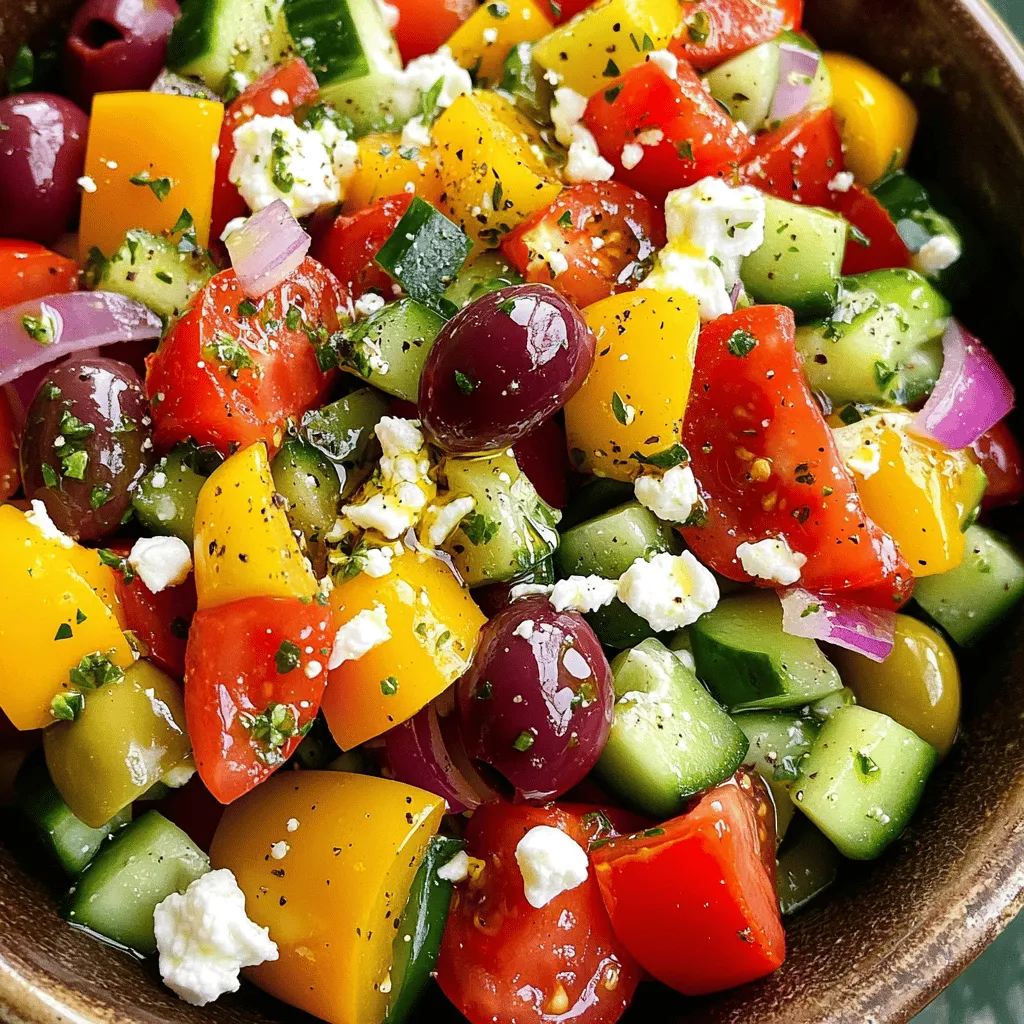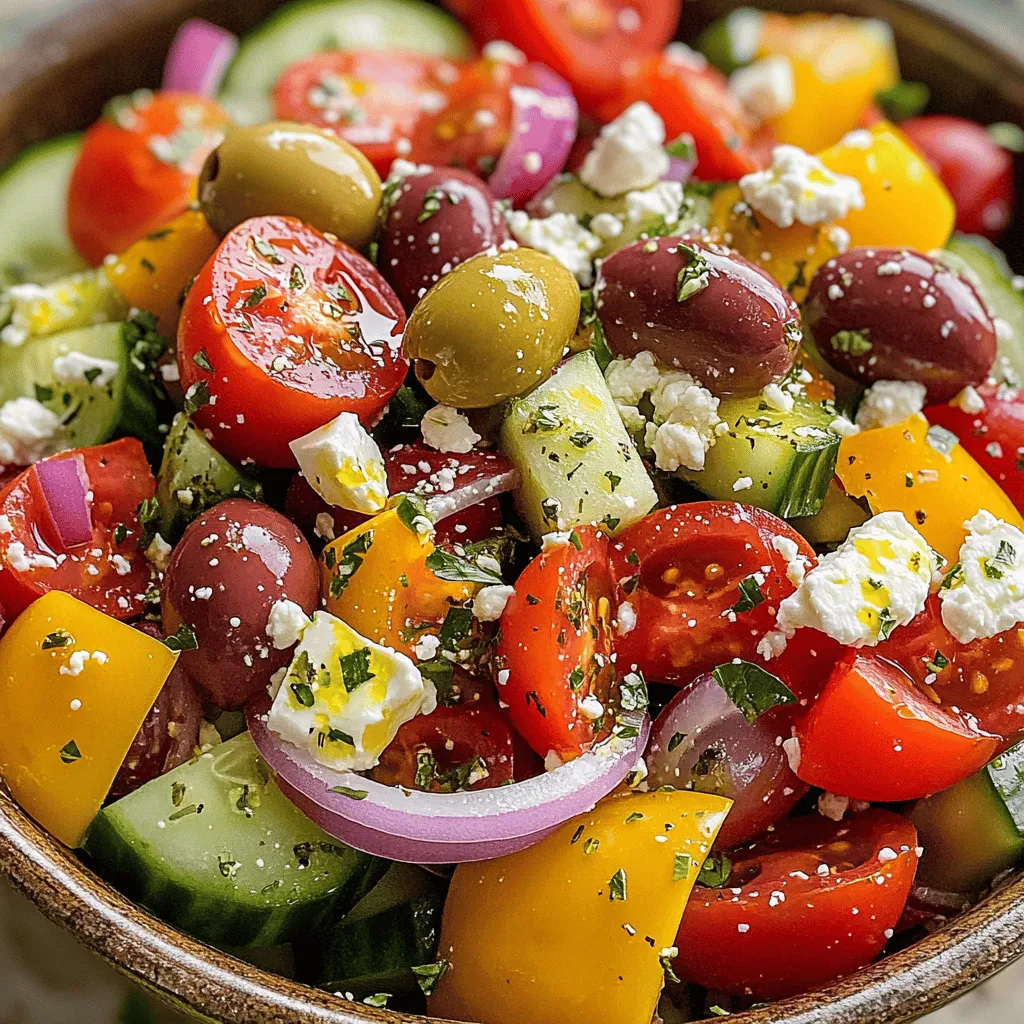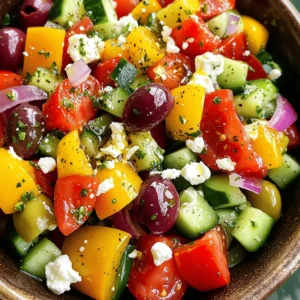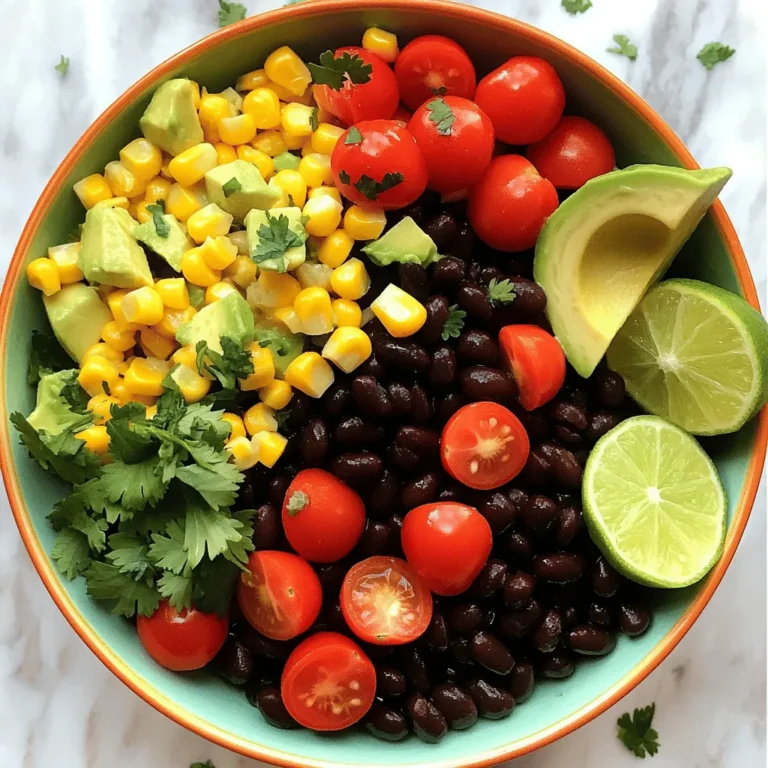Easy Greek Salad Fresh and Flavorful Recipe

Are you ready to brighten up your meals? This Easy Greek Salad is fresh, flavorful, and simple to make! Packed with vibrant veggies and creamy feta, it’s a dish that will please anyone at your table. In this article, I’ll guide you step-by-step through each ingredient and provide tips for adding your twist. Let’s dive into the joy of making this delicious Mediterranean classic!
Ingredients
Fresh Produce Needed
– 3 medium ripe tomatoes, diced into bite-sized pieces
– 1 medium cucumber, peeled and diced
– 1 bell pepper (choose your favorite color), diced
– 1 small red onion, thinly sliced
Fresh produce is key for a great Greek salad. Tomatoes bring juiciness and sweetness. Cucumbers add a nice crunch. Bell peppers give color and flavor. Red onion adds a sharp bite. Selecting ripe and fresh vegetables ensures your salad shines.
Feta Cheese and Olives
– 100g feta cheese, crumbled into small pieces
– 100g Kalamata olives, pitted and halved
Feta cheese is a must for Greek salad. It adds creaminess and tang. Choose high-quality feta for the best taste. Kalamata olives bring a briny flavor. They add richness and depth. Both ingredients make the salad feel authentic.
Dressing Components
– 2 tablespoons extra virgin olive oil
– 1 tablespoon red wine vinegar (or substitute with apple cider vinegar)
– 1 teaspoon dried oregano
– Sea salt and freshly cracked black pepper to taste
The dressing ties everything together. Extra virgin olive oil adds smoothness. Red wine vinegar gives a nice zing. Dried oregano adds an earthy note. Don’t forget salt and pepper to enhance the flavors.
Step-by-Step Instructions
Preparation of Vegetables
Start by washing all your fresh produce. For the tomatoes, cut them into bite-sized pieces. Aim for about one-inch chunks. Next, peel the cucumber. Slice it in half lengthwise, then dice it into half-inch pieces. For the bell pepper, remove the seeds and stem. Dice it into small squares, similar in size to the cucumber. Lastly, take the red onion. Slice it thinly to add a nice crunch and flavor.
Combining Ingredients
In a large mixing bowl, combine your diced tomatoes, cucumber, bell pepper, and red onion. Gently mix these vegetables together. This way, you ensure all flavors blend well. Next, fold in the crumbled feta cheese. Be careful not to break the feta too much. Add the halved Kalamata olives to the bowl, and mix them in gently.
Making the Dressing
In a separate small bowl, whisk together the extra virgin olive oil and red wine vinegar. Add the dried oregano and a pinch of sea salt. Whisk until everything blends smoothly. The dressing should look thick and creamy. This step helps create an emulsified dressing that clings to your salad well.
Tossing the Salad
Now, drizzle your dressing over the salad mixture. Using a spatula, toss the ingredients together gently. Make sure the dressing coats all the veggies and feta evenly. This helps each bite burst with flavor.
Final Adjustments
Before serving, taste your salad. You might want to add a bit more salt, pepper, or vinegar based on your preference. If you let the salad sit for about 10 minutes, the flavors will mix better. Finally, sprinkle finely chopped parsley on top for a fresh look.
Tips & Tricks
Flavor Enhancement Techniques
To make your Greek salad pop with flavor, marinate the veggies. Toss them with a bit of salt and let them sit for 10 minutes. This step draws out their juices and enhances the taste. You can also add a splash of vinegar to the mix for extra zing.
Allowing the salad to rest is key. After you toss it, let it sit for 10 minutes. This time helps the flavors blend nicely. The longer it rests, the better it tastes!
Presentation Suggestions
Serving style matters. Use a large, shallow dish to display your salad. This allows the colors to shine through. You can also serve it in individual bowls for a personal touch.
Garnishing adds flair. Sprinkle fresh parsley on top for color and aroma. You can also add a few whole Kalamata olives around the edge. These simple touches make your salad look gourmet.
Common Mistakes to Avoid
Avoid overmixing your salad. Gently toss the ingredients to keep the feta intact. Too much mixing can turn your salad into mush.
Watch your dressing proportions. Use the right amount of oil and vinegar for balance. If you add too much oil, the salad becomes greasy.

Variations
Additional Ingredients to Consider
You can easily change your Greek salad by adding protein. Grilled chicken adds heartiness. Shrimp gives a nice seafood twist. Both options make the salad more filling.
You might also try different cheese. Feta is traditional, but you could use goat cheese for a tangy flavor. Mozzarella gives a creamier texture. Each cheese adds its unique taste to the salad.
Customizing for Diets
If you want a vegan version, skip the cheese and add chickpeas. They provide protein and a nice texture. Use a vegan dressing made of olive oil and lemon juice.
For gluten-free diets, this salad is already safe. Just ensure all your ingredients are certified gluten-free. It’s a perfect option for those who need to avoid gluten.
Seasonal Variations
Using seasonal produce makes your Greek salad even better. In summer, ripe tomatoes taste amazing. In fall, try adding roasted squash for a warm touch. Winter greens like kale can also work well. Freshness makes a big difference in taste!
Storage Info
Short-term Storage Tips
To keep your Easy Greek Salad fresh in the fridge, follow these steps:
– Use an airtight container: This keeps air out and moisture in.
– Store without dressing: Keep the dressing separate until you serve to prevent sogginess.
– Keep veggies crisp: Layer the ingredients carefully to avoid bruising.
These simple tips help preserve the salad’s crunch and flavor.
Long-term Storage Considerations
For long-term storage, it’s best to store the dressing separately. Here’s how:
– Use a small jar: Pour your dressing into a small, sealed jar.
– Refrigerate the dressing: This keeps it fresh for a week or more.
– Shake before use: Always give it a shake before you pour.
Storing dressing apart ensures your salad tastes bright and fresh.
Shelf Life Insights
Leftovers from your Easy Greek Salad can be enjoyed, but timing is key. Here’s what to know:
– Consume within 3 days: For the best taste and quality, eat leftovers within three days.
– Check for signs of spoilage: Look for off smells or slimy vegetables.
– Revive flavors: If the salad loses some taste, add a squeeze of lemon or a dash of salt.
Sticking to these guidelines keeps your salad enjoyable and safe to eat.
FAQs
What is the origin of Greek salad?
Greek salad, or Horiatiki, comes from Greece. It is a classic dish that reflects the Mediterranean lifestyle. Traditionally, it includes fresh, local ingredients. You will find tomatoes, cucumbers, bell peppers, red onions, olives, and feta cheese in every bowl. The salad is simple but packed with flavor. It showcases the beauty of Greek cuisine and its focus on fresh, seasonal produce.
Can I make Greek salad ahead of time?
Yes, you can make Greek salad ahead of time. Just prepare the vegetables and feta cheese. Store them separately in the fridge until you are ready to serve. This helps keep the veggies crisp. Mix the dressing in a small bowl. Dress the salad right before serving to keep it fresh. If you prepare it this way, the flavors will still shine.
What’s the best way to serve Greek salad?
Serve Greek salad chilled or at room temperature. Use a large, shallow dish or individual bowls. It pairs well with grilled meats or fish. You can also enjoy it with pita bread and hummus. For a touch of flair, drizzle more olive oil on top. Add a few extra olives for decoration. This makes for a beautiful presentation.
Is the Mediterranean Bliss Greek Salad suitable for meal prep?
Absolutely! The Mediterranean Bliss Greek Salad is great for meal prep. Prepare it in batches and store it in airtight containers. Keep the dressing separate to maintain freshness. This way, you can enjoy it throughout the week. Just dress the salad before each meal. That keeps the veggies crisp and tasty.
How can I modify the recipe for my dietary needs?
You can easily modify this recipe. For a vegan version, skip the feta cheese. Instead, use avocado or a vegan cheese alternative. If you’re gluten-free, this salad is already safe. You can add protein like grilled chicken or chickpeas for extra sustenance. Adjust the ingredients to fit your taste and dietary needs. This salad is flexible and fun to make!
This blog post covers how to make a delicious Greek salad. We reviewed the needed ingredients, from fresh veggies to feta cheese. I shared step-by-step instructions for preparation and mixing. You’ll find tips for enhancing flavor and presentation. Variations for different diets and seasons were also mentioned.
In conclusion, Greek salad is versatile and easy to customize. With these steps, you can enjoy a fresh, tasty meal that fits your needs. Dive into making your salad and enjoy the vibrant flavors!







